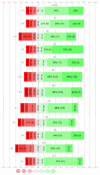Management of Local Skin Reactions Caused by 5-FU 4% Cream for the Treatment of Actinic Keratosis: A Delphi Consensus
- PMID: 40401863
- PMCID: PMC12090966
- DOI: 10.5826/dpc.1502a5787
Management of Local Skin Reactions Caused by 5-FU 4% Cream for the Treatment of Actinic Keratosis: A Delphi Consensus
Abstract
Introduction: Treatments such as 4% 5-fluorouracil (5-FU) cream have demonstrated strong efficacy in lesion clearance of actinic keratosis; however, local skin reactions (LSR) during treatment remain a significant challenge, potentially affecting patient adherence.
Objective: We sought to build consensus on management of LSR associated with 4% 5-FU using the Delphi methodology.
Methods: Twenty-eight expert dermatologists participated in a 3-round Delphi process. Experts evaluated LSR management strategies, including emollients, antibiotics, steroids, and treatment discontinuation. Agreement levels were measured using a 7-point Likert scale. Consensus was categorized as high if >80% of votes were within the 5-7 rating range and low when >25% were in the 1-3 rating range, with <25% of the votes in the 6-7 rating range. Other combinations of votes were considered as having moderate agreement.
Results: High agreement was achieved for the following statements: the approved daily schedule (once daily for 4 weeks) is the most appropriate (92.9%); mild LSR generally do not require intervention and do not impact treatment adherence (96.4%); severe LSR may benefit from temporary treatment interruption and emollient use, ensuring adherence without compromising efficacy (92.9%). The use of emollients (in parallel with the treatment with 5-FU) was considered not needed by most (moderate consensus, 64.3%). Experts emphasized the importance of clear communication about LSR during baseline consultation to enhance patient compliance.
Conclusion: This consensus provides practical guidance for managing LSR induced by 4% 5-FU, ensuring high adherence and optimizing treatment outcomes. Further research is needed to validate these findings and explore alternative management approaches.
Conflict of interest statement
Figures


Similar articles
-
Association Between Local Skin Reactions and Efficacy with 5-Fluorouracil 4% Cream in Actinic Keratosis: A Post-Hoc Analysis of Two Randomised Clinical Trials.Dermatol Ther (Heidelb). 2025 Feb;15(2):307-321. doi: 10.1007/s13555-024-01336-4. Epub 2025 Jan 16. Dermatol Ther (Heidelb). 2025. PMID: 39820963 Free PMC article.
-
Severity of Local Skin Reactions with 4% 5-Fluorouracil Plus Emollient versus 4% 5-Fluorouracil Alone in Patients with Actinic Keratosis: A Single-Blind Randomised Trial.Dermatol Ther (Heidelb). 2023 Apr;13(4):1013-1027. doi: 10.1007/s13555-023-00902-6. Epub 2023 Mar 1. Dermatol Ther (Heidelb). 2023. PMID: 36856965 Free PMC article.
-
Intensity of Local Skin Reactions During 5-Fluorouracil Treatment Related to the Number of Actinic Keratosis Lesions: A Post Hoc, Exploratory Analysis.Dermatol Ther (Heidelb). 2022 Feb;12(2):467-479. doi: 10.1007/s13555-021-00668-9. Epub 2021 Dec 26. Dermatol Ther (Heidelb). 2022. PMID: 34954811 Free PMC article.
-
Evaluating the Efficacy and Safety of 4% 5-Fluorouracil Cream in Patients with Actinic Keratosis: An Expert Opinion.Acta Derm Venereol. 2023 Nov 20;103:adv11954. doi: 10.2340/actadv.v103.11954. Acta Derm Venereol. 2023. PMID: 37982726 Free PMC article. Review.
-
Calcipotriol and 5-Fluorouracil Combination Therapy for the Treatment of Actinic Keratosis in the Clinic: A Review Article.Clin Drug Investig. 2024 Oct;44(10):733-737. doi: 10.1007/s40261-024-01392-w. Epub 2024 Sep 28. Clin Drug Investig. 2024. PMID: 39342018 Free PMC article. Review.
References
LinkOut - more resources
Full Text Sources
